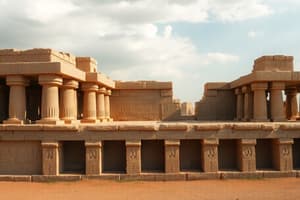Podcast
Questions and Answers
What were the main sources of food for the Chalcolithic people?
What were the main sources of food for the Chalcolithic people?
Domestic animals, hunting, and fishing, supplemented by crops like barley, wheat, and pulses.
What materials were used to make the walls of Chalcolithic houses?
What materials were used to make the walls of Chalcolithic houses?
Mud and cow dung, often plastered with lime.
What metals were used to make tools and ornaments during the Chalcolithic Age?
What metals were used to make tools and ornaments during the Chalcolithic Age?
Copper and its alloys.
What type of stones were used to make ornaments during the Chalcolithic Age?
What type of stones were used to make ornaments during the Chalcolithic Age?
What was the primary material used for making garments during the Chalcolithic Age?
What was the primary material used for making garments during the Chalcolithic Age?
What type of soil was suitable for producing cotton during the Chalcolithic Age?
What type of soil was suitable for producing cotton during the Chalcolithic Age?
What was the primary characteristic of the Bronze Age?
What was the primary characteristic of the Bronze Age?
What was the approximate time period when the transition from copper to bronze took place?
What was the approximate time period when the transition from copper to bronze took place?
What was the ratio of copper to tin in the alloy bronze?
What was the ratio of copper to tin in the alloy bronze?
What was the significance of the Bronze Age in the context of urban civilization?
What was the significance of the Bronze Age in the context of urban civilization?
Flashcards are hidden until you start studying
Study Notes
Code of Hammurabi
- The Amorite King Hammurabi created one of the world's earliest and most complete written legal codes.
- The Code of Hammurabi helped Babylon surpass the Sumerian City of Ur as the region's most powerful city.
Ancient Sumerian Inventions
- Mass-produced pottery
- Writing
- Hydraulic engineering
- The chariot
- The plough
- Textile Mills
- Mass-produced Bricks
- Metallurgy
Sumerian Clothing
- The length of the skirts varied according to hierarchical status.
- Servants, slaves, and soldiers wore short skirts, while royalty wore long skirts.
- They wrapped around the body and tied with a belt at the waist to hold the skirts up.
- Men and women wore skirts composed of woven cloth and tufted fabrics.
European Bronze Age
- Characterized by bronze artifacts and the use of bronze implements.
- Greece became a major hub of activities during the Bronze Age.
- The Minoans were the first advanced civilization in Europe.
- They traded timber, olive oil, wine, and dye to nearby Egypt, Syria, Cyprus, and the Greek mainland.
- They imported metals and other raw materials, including copper, tin, ivory, and precious stones.
European Fashion
- Clothing was made of wool with a simple weave.
- Leather was used as straps on clothes and shoes.
- Most clothing was a dark color.
- Textile tools such as spindle whorls and loom weights were made of clay and stone.
- Men wore caps made of either knitted thread or animal skin.
- Most people wore shoes.
- In cold climates, the fur was left on the skin and put on the inside of the shoes to help keep them warm.
Harappan Civilization (India)
- Located in the Indus River valley.
- Its two large cities, Harappa and Mohenjo-daro, were located in present-day Pakistan's Punjab and Sindh provinces, respectively.
- The Indus cotton industry was well-developed.
- People wore loin cloth for men, wrap skirts and shoulder shawls for women.
- Sandals were made from cloth and wood.
- Their cloths were made from cotton and woolen yarn.
Harappan Fashion
- Women were bare to the waist and wore only a scanty skirt.
- The skirt was held by a girdle made either of beads or a band of woven material.
- There were also dresses made from stiffened cotton cloth.
- Men were usually nude, and they would mostly wear an embroidery worn over their left shoulder and under the right arm.
- People were fond of jewelry and hair-dressing.
- Men had various hairstyles, including parting their hair in the middle and curling their hair.
- Metal ornaments were made out of gold, silver, copper, and bronze.
Bronze Age China
- The era of the Shang and the Zhou dynasties are generally known as the Bronze Age of China.
- The capital, and the land was controlled directly by the king.
- Farmers typically raised domestic animals such as sheep-goats, cattle, and pigs.
- A diet was supplemented by hunting and fishing.
- Use of bricks was extensive, but there are no traces of burnt (baked) bricks.
- Metals such as copper and its alloys were used to make knives, axes, fishing hooks, chisels, pins, and rods.
Chalcolithic Age (India)
- The people of the Chalcolithic Age were expert coppersmiths, ivory carvers, lime makers, and terracotta artisans.
- Ornaments were made from semiprecious stones and beads such as agate, jasper, chalcedony, and carnelian.
- People had knowledge of spinning and weaving.
- Flax, cotton, and silk thread were found from sites in Maharashtra.
- Cotton was produced in black cotton soil.
- Animal skins, woven fabrics were used to make garments.
Studying That Suits You
Use AI to generate personalized quizzes and flashcards to suit your learning preferences.




